Coral cay classification and evolution
Smithers, Scott, and Hopley, David (2011) Coral cay classification and evolution. In: Hopley, David, (ed.) Encyclopedia of Modern Coral Reefs: structure, form and process. Encyclopedia of Earth Science . Springer, Dordrecht, The Netherlands, pp. 237-254.
![[img]](https://researchonline.jcu.edu.au/19074/2.hassmallThumbnailVersion/19074_Smithers_%26_Hopley_2011_Book_Cover.jpg)
|
Image (JPEG) (Book Cover)
- Cover Image
Download (95kB) |
|
|
PDF (Published Version)
- Published Version
Restricted to Repository staff only |
Abstract
Islands associated with coral reefs have been occupied or used by humans for millennia. They became known to western society as voyages of discovery crossed tropical waters. A distinction has been made between "high" islands composed of continental rocks and "low" islands of biogenic carbonate sediments produced by reef organisms. The variety of morphologies that were observed became a focus of early studies:
"There are different opinions amongst ingenious theorists, concerning the formation of such low islands". (James Cook, 17 April, 1777)
Scientific studies of reef islands were first made in the nineteenth century in south-east Asia and the Australian Great Barrier Reef (GBR) and subsequently in the Pacific and Indian Oceans and in the Caribbean Sea (see Table 1; Stoddart and Steers, 1977) (see Steers, James Alfred (1899–1987); Stoddart, David Ross (1937–)). As the diversity of form became evident, various attempts at classification were undertaken. More recently research has extended to understand processes that form and maintain coral cays and their origin, age, and evolution. Many of these investigations, especially the development of classifications, were based on studies of the GBR (Spender, 1930; Steers, 1929, 1938; Fairbridge, 1950; Stoddart and Steers, 1977; Hopley, 1982, 1997; Hopley et al., 2007). The GBR is the largest reef province in the world, which when combined with the adjacent Torres Strait contains over 1,000 islands including approximately 350 coral cays (Hopley et al., 2007). Stretching over 15° of latitude and with reefs extending from the mainland to the shelf edge, the GBR provides a diversity of environments which are responsible for the great variety of coral cay types found within its waters (see entry: Section 10.1.3 in Hopley et al., 2007).
| Item ID: | 19074 |
|---|---|
| Item Type: | Book Chapter (Research - B1) |
| ISBN: | 978-90-481-2639-2 |
| Date Deposited: | 18 Jan 2012 02:50 |
| FoR Codes: | 04 EARTH SCIENCES > 0406 Physical Geography and Environmental Geoscience > 040601 Geomorphology and Regolith and Landscape Evolution @ 100% |
| SEO Codes: | 97 EXPANDING KNOWLEDGE > 970104 Expanding Knowledge in the Earth Sciences @ 100% |
| Downloads: |
Total: 466 Last 12 Months: 4 |
| More Statistics |



